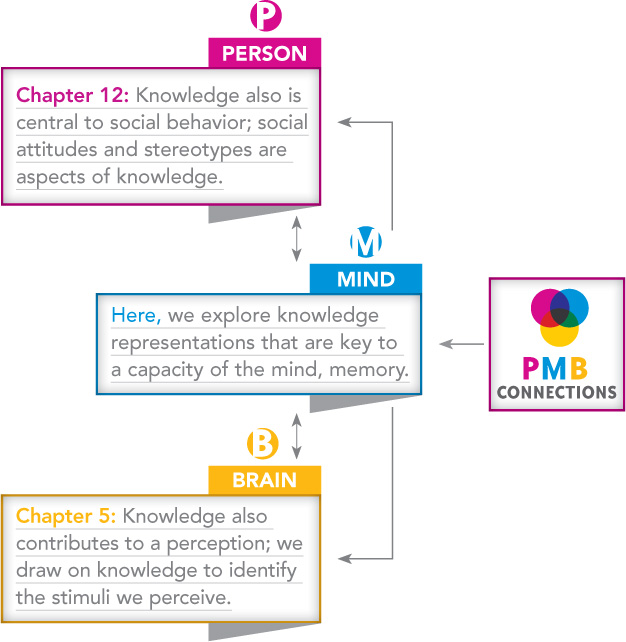6.4 Models of Knowledge Representation
Have you ever watched a quiz show and wondered how the winner knew so much? The famous American on the hundred dollar bill, the names of the Three Musketeers, the director of the 2014 Oscar winner for Best Picture. … But it’s not just quiz show winners who possess a huge amount of knowledge. You do, too. You easily can recall zillions of facts: the name of your high school, whether Mexico is south or north of the United States, the approximate price of a gallon of milk. You also can remember how to do a zillion things: scramble an egg, drive a car, ride a bike, speak in grammatically correct sentences. Now that we’ve seen how information makes its way from sensory to short-
Psychologists address this question by studying knowledge representation, which refers to the form in which we retain knowledge in long-
Instead of asking how knowledge is represented in the human mind, suppose you asked, “How is knowledge represented in libraries?” (Let’s put aside digital storage and Internet access and imagine a traditional library with hard-
Psychologists ask this question about the mind. To answer it, they have proposed three main theoretical models, each of which contributes to our scientific understanding of memory and mind: semantic network, parallel distributed processing, and embodied cognition models.
Semantic Network Models
Preview Questions
Question
 What is a network?
What is a network?
Question
 In a semantic network model of memory, what determines how closely any two concepts in the mind are related?
In a semantic network model of memory, what determines how closely any two concepts in the mind are related?
Question
 Are people generally aware of when ideas in their minds have been primed?
Are people generally aware of when ideas in their minds have been primed?
To introduce the idea of semantic networks, let’s first look at the idea of a network, which is any collection of interconnected elements. The Internet, for example, is a communications network in which the elements that are interconnected are computers. In any network, elements in the network vary in how closely they are connected to one another. Two computers in a science laboratory might be closely connected, through a local network that serves the lab, and distantly connected, through the Internet, to a computer on the other side of the world.
In many networks, if two elements have a close connection, activating one of them will strongly influence the other. As an example, imagine a physical network, such as a fishing net. The knots represent the elements of the network. They are connected by cords running from one knot to another. If you shake one knot, the knots closer to it will move a lot, but knots farther away may move only a little.
Now, let’s use these ideas to understand the mind. A semantic network model is a conceptual model of long-

What determines how closely any two concepts are related in the mind? In principle, it could be anything: size (maybe concepts of whales and passenger planes will be closely related), color (licorice and bowling balls), or sound (actors and tractors). However, what usually connects two concepts is semantics. Semantics refers to the meaning of words, sentences, or other communications. “Cold” and “snow” are semantically similar because they are both related in meaning to the idea of winter weather. “Vacation” and “tan” are related in meaning to “spring break.”
In the semantic network model shown in Figure 6.9, the mind processes one concept at a time (Collins & Loftus, 1975). In this network, you may be thinking about fire engines at one moment, and at the next, ambulances. The distance between two concepts—

In your own semantic network, what is the distance between the concepts psychology and fascinating?
RESEARCH TOOLKIT
Priming
How do psychologists know that ideas in the mind are associated with one another? A key research tool for demonstrating these mental connections is priming. Priming occurs when exposure to information activates a concept in your mind that you use in your subsequent thinking. The information is said to “prime” the concept.
Here is a simple example. Pronounce these three words as you read them:
bait
hook
bass
Now pronounce these three:
drums
guitar
bass
Your pronunciation of “b-
How does priming work? According to semantic network models, concepts have a certain amount of activation at any given time (Collins & Loftus, 1975). Activation is the ease with which a concept comes to mind at any given time (Bruner, 1957). In the example above, “drums” and “guitar” increased the activation level of the concept “music.” Once this happened, the concept affected your thoughts about the letters “b-
Even very brief priming can activate concepts in memory. For example, in one experiment (Gillath et al., 2008), researchers presented erotic photographs extremely briefly: for 30 milliseconds (less than 1/30th of a second). In another condition, they presented nonerotic photos for the same duration. The researchers then asked participants, all of whom were in romantic relationships, how willing they would be to sacrifice other parts of their lives (time spent on hobbies or with friends) to spend more time with their romantic partners. Compared with those who saw neutral photos, participants briefly primed with erotic photos were more willing to make such sacrifices (Gillath et al., 2008). Why would viewing erotic photos for 1/30th of a second have this effect? The photos prime erotic concepts that, in turn, activate concepts about romantic relationships, which are closely linked in people’s semantic networks. The activation of romantic concepts then influences people’s thinking when they are asked if they would make sacrifices to spend more time with romantic partners.

WHAT DO YOU KNOW?…
Question 7
True or False?
Priming is a research tool that can be used to demonstrate that concepts are related to one another in a semantic network.
| A. |
| B. |
Concepts can become active in memory without your even knowing it. People often are not aware of how concepts are connected in their memory or how activation spreads throughout their semantic network. They sometimes aren’t even aware of the events that prime concepts; in the priming study described in the Research Toolkit, photos were presented so briefly that the participants weren’t even aware of their content. Nonetheless, priming affected their thinking.
What are the external events in your current environment? What concepts could they be priming?
This lack of awareness has important implications for everyday behavior. People’s behavior can be affected by social factors of which they aren’t even aware. Briefly presented information—
In sum, semantic network models have proven valuable for understanding how knowledge is represented in the mind. By modeling knowledge as a network of linked concepts, psychologists can explain how ideas trigger one another, and how social influences affect thinking. Yet, as the study of mind advanced in the latter decades of the twentieth century, psychologists identified limitations to the semantic network approach and sought alternatives.
CONNECTING TO PERCEPTION AND SOCIAL ATTITUDES

WHAT DO YOU KNOW?…
Question 8
According to semantic network models of long-
Parallel Distributed Processing Models
Preview Question
Question
 What are the basic elements in a parallel distributed processing model of mind?
What are the basic elements in a parallel distributed processing model of mind?
An alternative to semantic network models is parallel distributed processing models of knowledge representation, or PDP models, for short (McClelland & Rogers, 2003; Rogers & McClelland, 2004; Rumelhart, McClelland, & the PDP Research Group, 1986). The PDP approach differs from semantic network models in the following manner.
In semantic network models, the simplest elements were individual concepts; concepts such as cars, trucks, and vehicles (Figure 6.9) were interconnected in the network. In PDP models, the basic elements are much simpler: processing units that do nothing other than turn on or off. No individual processing unit represents a concept. Rather, concepts are represented by patterns of activation in large numbers of units.
An analogy helps explain this. Imagine an electronic sign made up of numerous individual light bulbs; let’s say it’s a sign that displays scrolling news headlines, and the headline at the moment is “John Kerry visits Russia.” Now answer two questions: (1) Which light bulb represents the concept “John Kerry”? (2) Which light bulb is scrolling? Obviously, no individual light bulb represents the concept and no light bulbs are scrolling. The information represented in the sign is contained in the sign as a whole. PDP models are like this. Many individual units take part in representing any piece of knowledge; the knowledge thus is “distributed” across the units.

An appealing feature of the simple units in PDP models is that they resemble, in their simplicity, the units contained in the brain: neurons, or brain cells (Chapter 3). Neurons turn on and off; that is, they fire (“on”) or are in a resting state (“off”). Similarly, the units of a PDP model either turn on or off. Inputs from other neurons determine whether a given neuron fires. Similarly, inputs from other processing units determine whether a given PDP processing unit turns on. The resemblance between PDP models and brain processes is an advantage in pursuing the long-
THINK ABOUT IT
Are there some aspects of memory that semantic network and PDP models do not explain? When you remember an experience that was personally embarrassing, you do not merely recall the information. You also relive the embarrassment; you have a “whole body” feeling that accompanies your memory. How can psychologists start to explain these bodily feelings that occur during some memories? (Hint: See the section on embodied cognition below.)
WHAT DO YOU KNOW?…
Question 9
Contrast the simplest elements of the semantic network model with those of the parallel distributed processing (PDP) model. What do the PDP’s simplest elements resemble, at the level of the brain?
Embodied Cognition
Preview Question
Question
 How does an embodied cognition approach to memory differ from semantic network and PDP models?
How does an embodied cognition approach to memory differ from semantic network and PDP models?
Our first two models of knowledge representation, semantic networks and parallel distributed processing, were the primary theories informing research on memory and mind in the last quarter of the twentieth century. Here in the twenty-
The central question embodied cognition theorists address is, “When you think, what part of your mind do you use?” The question might seem silly; it’s the “thinking part”—some part of mind devoted to memory, reasoning, and other types of complex thought—
Bodily movements can affect concentration. When participants took four steps (a) forward, (b) backward, or (c) sideways before performing a task that required concentration, their performance was better after stepping backward (Koch et al., 2009).
The physical warmth of a held object can influence thoughts about other people. When participants held hot coffee before rating someone’s interpersonal “warmth,” their ratings were higher than if they had held iced coffee (Williams & Bargh, 2008).
Perceptual variables influence the speed of conceptual thinking. When participants judged, as quickly as possible, whether blenders are “loud” (i.e., whether the concept “blender” is associated with the property “loud”), they answered more quickly if they previously had been asked whether leaves rustle than whether cranberries are tart (Barsalou et al., 2003).
From the perspective of semantic network and PDP models, these findings are weird. Why would bodily movements affect concentration or physical warmth affect thoughts about other people? Why would thinking about leaves speed thinking about blenders—
Here’s how embodied cognition explains the three findings above:
Moving backward is associated with avoiding objects. Avoidance movements usually occur in potentially harmful situations that require concentration (to avoid the harm). The part of mind that causes you to step backward thus increases concentration.
Judgments of interpersonal warmth are made using the same perceptual systems that are used to judge physical warmth. “Warming up” that system with hot coffee thus influences the interpersonal judgments.
Even if there is no loud blender in their vicinity, people use their auditory system (the perceptual system that detects sound; Chapter 5) to judge whether blenders are loud. The question about rustling leaves activates the auditory system, so it is ready to use, speeding judgments, when people think about the loudness of blenders.
In each case, a part of the mind that normally carries out perception or bodily movement—
Figure 6.10 contrasts semantic network and embodied cognition approaches to memory (Barsalou et al., 2003). In a semantic network model, perceptual systems play no role in remembering; they are active only when people first experience an event. In embodied cognition, by contrast, the visual system is active both when people experience an event and when they remember it. People remember information by reactivating their original perceptual experience, essentially “replaying” events in their mind.

Embodied cognition is consistent with evolutionary principles (Glenberg, 2010). In the distant past, survival required keen perception (e.g., to spot prey) and good motor skills (to evade predators and create tools; Mithen, 1996). Human perceptual and motor systems evolved to meet these needs. Once they evolved, these same systems were used for thinking; the evolved brain systems got “recycled” (Dehaene, 2004). Parts of the mind and brain that evolved to perform one function (e.g., perception, movement) were reused for others (e.g., thinking, memory).
An aspect of everyday thinking that embodied cognition can explain is people’s frequent use of metaphors. Metaphors are figures of speech in which one thing is described in terms of something else to which it is not directly related. If you say a friend is in “the depths” of depression or an athlete is at “the height” of her career, you are using physical metaphors (depth, height) to describe emotion and achievements. Why are such physical metaphors so common? Semantic network and PDP models don’t tell us, but embodied cognition does. Our visual system, which evolved to detect the presence and location of physical objects, takes part in thinking. When it does, it brings its physical framework with it, which fosters physical metaphors when thinking (Lakoff & Johnson, 1999).
Whom do you “look up” to? In coming to admire this person, were there occasions when you literally looked up to him or her?
WHAT DO YOU KNOW?…
Question 10
According to cognition, bodily metaphors may have their origins in physical experiences. For example, getting a “cold shoulder” from someone may cause us to literally feel .